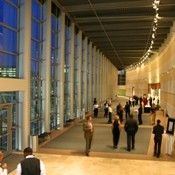Just as high hotel occupancies and room rates are not likely to go away in 2007, neither will the challenges facing meeting planners searching for value destinations, as flexibility on dates and location will continue to be the keys for survival in the months ahead.
Although the aftermath of Katrina and other hurricanes is still being felt in some locations, most Southern cities are sharing in the national burst of prosperity that has brought the sellers’ market back in full force.
“There is no region of the U.S. that is not enjoying this peak era of high occupancies and room rates,” says consultant Robert Mandelbaum, director of hospitality research for PKF Consulting in Atlanta. “We will be in this peak for a fairly extended time, with hotel managers doing what they can to keep the rates as high as possible.”
Bill Briscoe, Florida-based chief industry relations officer for site selection firm HelmsBriscoe, says he finds that hotels all over the Southeast are in a strong position with rates, although he saw a little softening last August and September.
“Even though last year was not a bad hurricane season, people are still gun shy,” he says. “But in general, we’re back to the late 1990s in terms of how well the hotels are doing.”
According to figures from Smith Travel Research, major cities throughout the South experienced an average increase in hotel room rates of 10.4 percent during the first nine months of 2006 when compared to the same period in 2005, beating the national average increase of 9.2 percent.
These 2006 rates represent a fairly wide range, with Florida’s West Palm Beach and Miami leading the pack at $160.95 and $150.35, respectively. By contrast, average rates in Charlotte, N.C., ($75.91), Columbia, S.C., ($69.94), Richmond, Va., ($77.96), and Memphis, Tenn., ($80.26) were relatively modest.
While hotel rates and occupancies are not expected to grow quite as much this year as they did during 2005 and 2006, Mandelbaum says a continued lack of new supply is among the dynamics keeping things rosy for hoteliers. “Because construction costs are so high, we’re seeing more acquisitions of existing properties rather than new-builds,” he says. “This keeps rates high because little new competition is being created.”
Strategies for Success
So what’s a planner with a limited budget to do? For Jeanne Torbett, president of Superior Media, Meetings & Management in Jacksonville, Fla., who primarily handles state association business, creative strategies are the answer.
“I don’t like to sacrifice location, so I have become more flexibile,” she says. “I recently saved $30 on a room rate just by moving the meeting back a week.” Torbett also searches out hotels that have just opened or are even still under construction.
“When hotels are brand-new, they are often hungry for business,” she says. “I contacted The Ritz-Carlton, Sarasota when they first opened and got a rate of $155 a night—about half of what they charge now.”
Another tactic she employs is to hold two or more meetings back-to-back or close together at the same hotel.
“I recently got a really good deal at the Universal Portofino in Orlando by booking two groups within two weeks of each other,” she says.
Similarly, Walter Caudle, an independent meeting and event planner based in Columbia, S.C., has found that flexibility works at just about any destination.
“I don’t necessarily avoid the major hotels and venues. You never know – they might have some dates they really need to fill,” he says. “I also find that maintaining strong relationships with certain hotels helps more than ever these days.”
Caudle believes that his home city of Columbia is an especially good value for affordable meetings now, partly because a new 222-room Hilton hotel is opening adjacent to the convention center this spring.
“For the first couple of years the Hilton will be trying to fill its dates,” says Caudle, who is president of the MMTG Group. “At the same time, we have lost some of our major corporate players here to mergers, so corporate business is down.”
Changing Scene
John Keeling, who analyzes the south-central states market for PKF Consulting in Houston, says that it’s important to look at the changing dynamics affecting various cities, meaning that a city that is not a value destination this year could become one next year.
“For example, Austin [Texas], which has fully recovered from the dot-com bust, is a very hot meetings destination right now,” he says. “However, they are adding a lot of new hotel inventory over the next few years and there is some concern over how they will fill rooms in 2010. So if you’re planning a meeting three or four years out, Austin could be a very good deal.”
Conversely, New Orleans, which still offers more negotiating room than many cities because of the lingering fallout from Katrina, is likely to become less negotiable in the future.
“In a few years we could see New Orleans hard to get into and Austin easier to get into—a total reversal of the situation,” Keeling says.
Pointing to another changing scenario, Keeling mentions North Dallas as a location that is becoming a better value for meetings, largely because of brisk hotel development in nearby Plano that has diverted some business from properties such as the Westin Galleria.
“North Dallas has become a very good area to find negotiable rates because the center of business has shifted north,” he says.
Suburban Bargains
For planners who don’t want to pay first-tier rates but still want an accessible location, the answer can sometimes lie just outside a major city. This is the message promoted by the Gwinnett CVB, which represents the city of Duluth, Ga., located about 30 minutes from Atlanta.
“We position ourselves as an affordable and convenient alternative to downtown Atlanta and even some of the suburbs,” says Lisa Anders, the CVB’s marketing communications director. “Our average daily rates are $30 to $40 less and we also offer free parking at our convention center, a savings of $10 to $20 a day in Atlanta.”
According to Anders, a growing number of groups are drawn to Duluth, which focuses primarily on state and regional association business requiring up to 1,200 rooms. “Our convention center had its best year ever last year,” she says. “We’re seeing more groups come here because rates are getting so high.”
Value Periods
While their rates are higher overall, major cities still offer value periods, and most CVBs and hotels will work with planners in searching them out.
“Yes, it’s a sellers’ market, but I’ve never seen a city yet that is full 365 days a year,” says Butch Spryidon, president of the Nashville CVB. “If you can be flexible on dates, we’ll provide some real incentives for value.”
In San Antonio, where hotel occupancies and rates are among the highest in Texas, the CVB is working harder than ever to steer planners toward value periods, according to the CVB’s director of sales, Steve Clanton.
“We know it’s more difficult for people to find affordable rates, so we’ve done more staff training on this,” he says.
In particular, dates on or near holiday periods can provide good value.
“We just had a large state group, one who normally can’t afford to meet here, come in a week after Thanksgiving and take 1,500 nights,” Clanton says. “More groups are willing to do this.”
Jim Wood, president of the Greater Louisville CVB, also notes the trend.
“We’re seeing more conventions choosing holiday periods, even between Christmas and New Year’s,” he says.
Wood also says that planners need to look at more than just hotel rates to determine if a city provides value.
“One thing that makes us a good value is that we have a strong mix of hotels within walking distance of the convention center,” he says. “This saves people time as well as money.”







